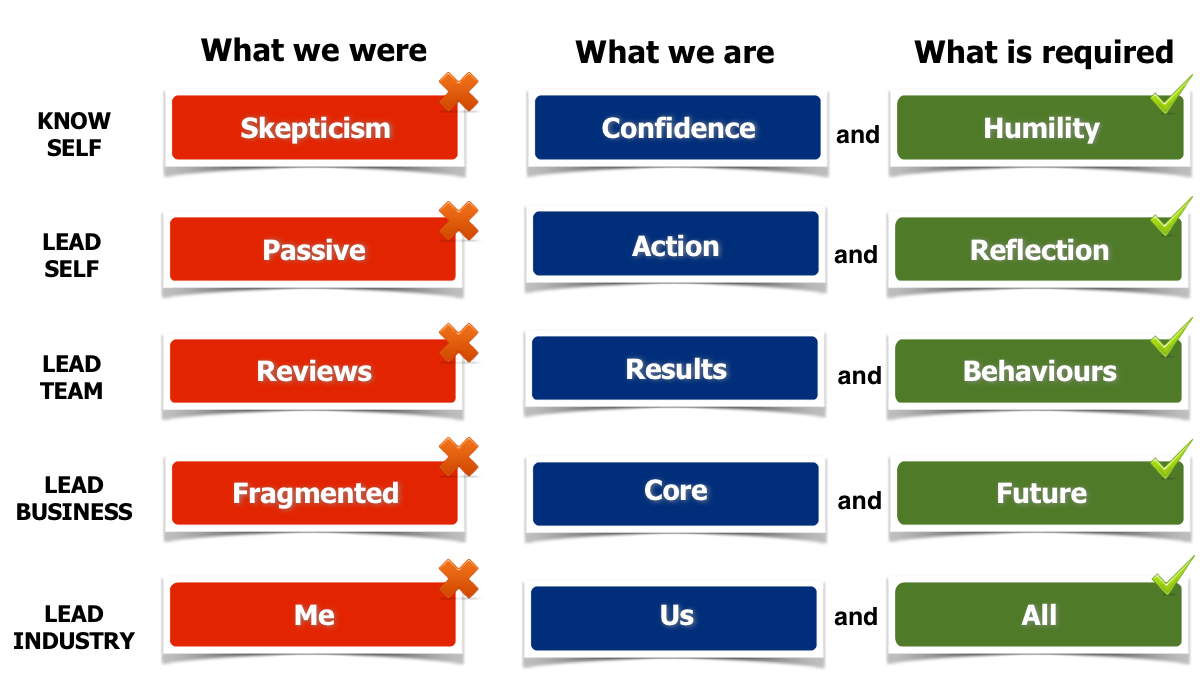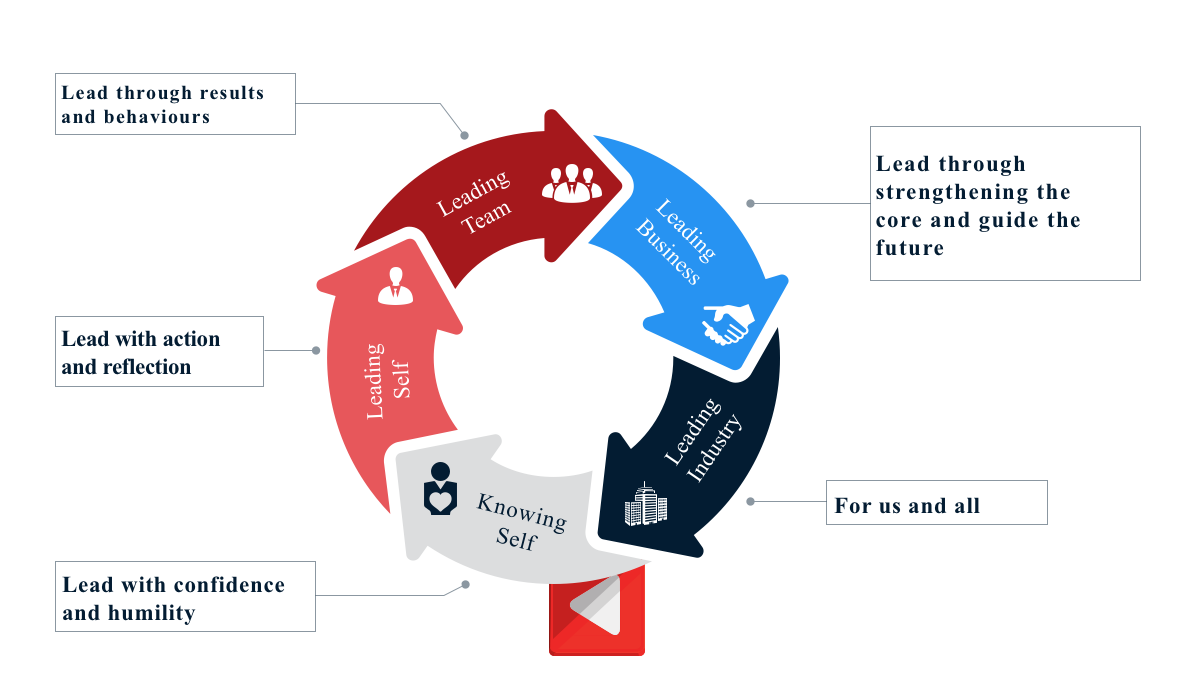In 2018 disruption driven by technology, consumers and AI will accelerate. Disruption is no longer just a catch phrase. Cultivating Leadership for this unpredictable environment is not only required, but it is also essential for survival. For leaders, disruption typically takes place on two levels. Firstly, long-standing business models are disrupted, and secondly, self-disruption takes place. Self-disruption is a natural outflow, as the two concepts are inseparable.
Every day Leaders are required to deal with many competing priorities. They have to:
- Act and deliver – with speed, urgency, and decisiveness.
- Interpret and visualize the future, engaging employees and key-stakeholders.
- Lead from the front, with humility.
- Have an adaptive mindset in a disruptive environment with the ability to continually re-position the business.
According to KPMG’s Global Outlook, disruption and growth are inseparable. Constant change, even in uncertain times, is becoming increasingly necessary for business success. Progressive companies will focus the development of their leaders through non-traditional models. The future trends in developing leadership are discussed in a White Paper by the Centre for Creative Leadership. In summary, they propose that leadership development will take the following direction:
- More focus on Vertical development – rather than receiving training from a single expert (horizontal development), vertical development will be earned i.e. self-development
- Transfer of ownership for development to the individual – the leader becomes responsible for their own growth.
- Greater focus on collective, rather than individual leadership – leadership development becomes a collective process spread throughout networks of people.
- Much greater focus on innovation in leadership development methods.
As we look at 2018, what will continue to be the key business disruptors, globally?
- Customers. Foremost, this is likely to continue to be the biggest driver of global disruption. How customers want their products, in what form, where and when will continue to drive disruption of any business model.
- Technological advances. Better and smarter technology allows for better and more efficient production processes.
- Competitors. The rapid rate of disruption and emerging competitors in sectors previously protected by patents and high entry costs.
- Where and at what rate customers want their products will continue to have a massive impact on distribution channels and methodologies
Disruption will continue, but what business trends can we expect in 2018?
Ian Altman in a Forbes Article – The top 10 Business trends that will drive success in 2018 identified key business trends. Some of the relevant thoughts for this article are:
- Artificial Intelligence drives customer experience – innovative leaders realize that AI in performing repeatable and redundant tasks, does not avoid human interaction, it enriches it.
- Communities embrace live interactions over social media – top companies realize that building greater communities engenders brand loyalty. Nothing drives strong communities better than in-person and live interactions.
- Social learning outperforms remote learning – social learning takes place through peer social interaction. Bet on successful companies to develop mentoring and coaching tools that leverage internal expertise organically.
- Live streaming video content gains momentum – customers demand real connections with real people. Companies who plan for and dedicate resources to live stream videos will dominate their industries.
- Millennials welcome Generation Z – those born after 1998. Gen Z’s are now entering their formative years and rising in influence. It is estimated that this group will soon outnumber their millennial predecessors. Millennials are increasingly in leadership positions and will soon supervise Gen Z employees. Will the Millennials complain as much about Gen Z employees as the Baby Boomers did of Millennials? Gen Z consumers are the first ones born with devices in their hands, so smart leaders are racing to understand the impact of Gen Z both a consumer and an employee.
The new face of Leadership – Organic growth is required for leaders to thrive in disruption


The new face of Leadership is one of organic and transformational growth. It is about the emergence of disruptive leaders, leaders that thrive and grow in disruption. And growth starts with self-awareness. Growth that moves away from positional power, to a leader of influence. Leaders have things they know about, that keep them up at night, and some stay awake concerned about what they don’t know. Organizations get flatter, information is more readily available, and empowerment becomes increasingly critical to succession. These elements continue to democratize leadership to all levels of the organization

Cultivating disruptive leadership for this unpredictable environment is not only required, but it is also essential for survival. should respond to this environment by not perceiving disruption as having a negative impact. It is an opportunity waiting to be embraced. To achieve this, consider the following strategies:
- Challenge your own leadership and your role. Is your role one of positional power, or do you empower and influence your team to cultivate innovation, risk-taking, and creativity? The key findings from the PWC Global CEO Report explains the impact of robotics and artificial intelligence on people, and how CEO’s should respond. “Twenty years ago, there were fewer than 700,00 industrial robots worldwide; today there are 1.8 million, and the number is expected to soar to 2.6 million in another two years. More than three-quarters of CEOs globally believe technology will cause job losses over the next five years. The role of the CEO is to not see this as a threat, but recognize the window of opportunity to rethink and redesign the way they employ, manage and interact with people”.
- Many senior executives are spending more time than ever on self-development and self-management strategies. Understanding what drives you and what derails you, has great benefits.
- Stay focused on leveraging your core business, and at the same time developing strategies for entering future growth businesses.
- Build organizational resilience, in your leadership and your employees. A disruptive environment has a big impact on employee well-being and ability to manage their work life. Steve Worrall, the Managing Director of Microsoft Australia, said that: “New technology is exacerbating peoples already demanding lives. So, empathy is critical for senior leaders to enable their employees to be more efficient and productive. I want to ensure my team, and my clients are not overwhelmed. They need to have a sense of wellbeing and balance to thrive in the complex environment, but to also have a rich and full life with their families.”
- Focus and exploit cognitive technology – artificial intelligence such as robotics, speech recognition, and machine learnings. Cognitive technology will most certainly impact headcount levels, but smarter more technological ways of doing business will act as counter and open avenues for job creation.
Start by developing and leading yourself in order to grow. Personal growth is a powerful tool and leads to greater Influence. Working with disruption as an opportunity, rather than a threat, builds leadership agility and as a result, future-proof leaders and their businesses.
It is the new face of leadership. It is the emergence of the disruptive leader.

